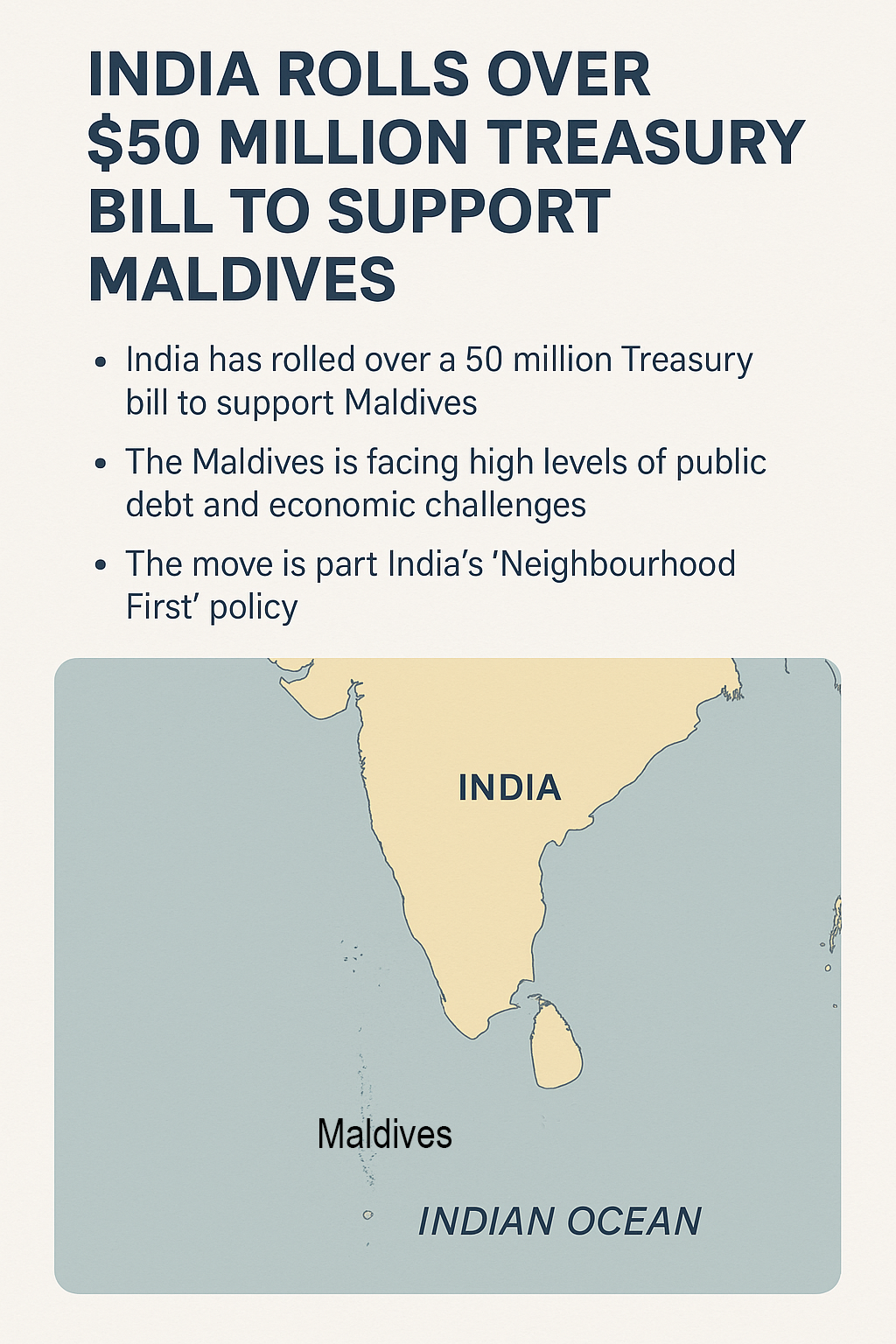
May 15, 2025, Post 2: India Rolls Over $50 Million Treasury Bill to Support Maldives |High Quality Mains Essay | Prelims MCQs
India Rolls Over $50 Million Treasury Bill to Support Maldives

NATIONAL HERO — PETAL 002
📅 May 15, 2025
Thematic Focus: India–Maldives Relations | Strategic Diplomacy | Economic Support
🌊 Intro Whisper
Even amid turbulent tides of political tension, India extended a steadying hand across the ocean — reaffirming its commitment to the Maldives with a financial lifeline.
🔍 Key Highlights
- What Happened?
India rolled over a $50 million Treasury Bill to support Maldives, executed via the State Bank of India. This rollover extends the maturity of an earlier bill for one more year — a move requested by the Maldivian government. - Why It Matters?
• Maldives is grappling with severe debt, with public debt exceeding 134% of its GDP.
• India’s support provides crucial relief amid credit downgrades, low forex reserves, and looming debt repayments in 2025–26. - Strategic Message
This act is not just financial aid — it’s a calculated signal of India’s ‘Neighbourhood First’ policy, seeking to counterbalance China’s growing influence in the Indian Ocean.
📘 Concept Explainer
What is a Treasury Bill Rollover?
Treasury Bills (T-Bills) are short-term government securities. A rollover means the investor — in this case, SBI — reinvests the maturing T-bill proceeds into a new T-bill, essentially extending the financial assistance without fresh disbursal.
India-Maldives Strategic Context
- Historic Ties: India and Maldives share deep maritime and cultural bonds.
- Trade: Bilateral trade rose to $548 million in 2023.
- Connectivity: Projects like GMCP (Greater Male Connectivity Project) strengthen ties.
- Tourism: India remains the top source for Maldivian tourism.
- Defence: India has been a steady partner in Maldives’ maritime security since 1988.
- Diplomatic Challenges: Frequent leadership changes and China’s economic presence strain long-term commitments.
🗺️ GS Paper Mapping
| 📘 GS Paper 2 | Bilateral Relations — India & Neighbourhood; India’s Foreign Policy |
|---|---|
| 📘 GS Paper 3 | Economy — External Debt, Fiscal Reforms, Strategic Financial Aid |
💭 A Thought Spark — by IAS Monk
In diplomacy, silence speaks — and so does credit. The act of rolling over a Treasury Bill is not mere arithmetic; it is a quiet extension of trust — a bridge built not with bricks, but with belief.
High Quality Mains Essay For Practice :
Word Limit 1000-1200
India’s Relations with Indian Ocean Countries: Anchoring Peace, Prosperity and Power
Introduction
The Indian Ocean, often described as the maritime heartland of the 21st century, holds pivotal geopolitical, economic, and strategic importance. India, nestled at the center of this vast water body, finds its destiny closely entwined with the Indian Ocean Region (IOR). The country’s historical trade routes, civilizational ties, cultural exchanges, and modern strategic imperatives all converge around this maritime space. As global attention shifts eastward and maritime rivalries intensify, India’s relations with Indian Ocean countries have gained renewed momentum — guided by security concerns, energy routes, economic integration, and a vision of regional stability.
The Strategic Centrality of the Indian Ocean
The Indian Ocean covers one-fifth of the world’s ocean area and hosts major sea lanes of communication (SLOCs) that are vital for international trade and energy supply. Over 80% of global oil trade and 40% of container traffic passes through its waters. The Indian Ocean connects the energy-rich Gulf nations to East Asia and the manufacturing hubs of Asia to global markets.
India’s geographical location provides it with a commanding presence over these crucial maritime corridors — making its maritime diplomacy and naval capability central to regional order. From the Strait of Hormuz in the northwest to the Strait of Malacca in the east, India’s maritime arc of influence positions it as both a stakeholder and a stabilizing force in the IOR.
Historical and Cultural Linkages
India’s ties with the Indian Ocean littoral countries date back centuries — through the maritime silk route, Chola naval expeditions, spice trade, and Buddhist pilgrimages. These historical links underpin India’s modern soft power appeal in the region, particularly in Southeast Asia, Sri Lanka, Maldives, and East Africa. Languages, art, cuisine, and religion bear testimony to these enduring connections.
India’s Multidimensional Engagement with Indian Ocean Countries
1. Bilateral Partnerships and Economic Ties
- Maldives: India is the Maldives’ key strategic and economic partner. India’s ‘Neighbourhood First’ policy ensures it extends lines of credit, builds infrastructure (e.g., Greater Male Connectivity Project), and supports security capacity.
- Sri Lanka: India is among Sri Lanka’s top trade partners and foreign investors. Despite some political divergences, India has extended humanitarian assistance and infrastructure projects like railway modernisation and energy grid connectivity.
- Mauritius & Seychelles: These island nations are key security and diplomatic partners. India has provided coastal radar systems, defense cooperation, and concessional loans for development projects.
- Indonesia & Thailand: Under the ‘Act East Policy’, India emphasizes connectivity (India–Myanmar–Thailand Highway), maritime trade, and defense dialogues.
- Iran: The Chabahar Port project exemplifies India’s strategic ambitions to bypass Pakistan and connect with Central Asia and Afghanistan.
- Africa’s Eastern Seaboard (e.g., Kenya, Mozambique, Madagascar): India’s involvement includes trade, energy exploration, health diplomacy, and climate resilience initiatives.
2. Maritime Security and Naval Diplomacy
India has adopted the concept of Security and Growth for All in the Region (SAGAR) — a strategic vision that promotes collective security and maritime cooperation. Under this doctrine:
- India conducts joint naval exercises (like Milan, Malabar, IND-INDO CORPAT) with IOR countries.
- The Indian Navy’s Mission-Based Deployments maintain near-continuous presence in critical sea lanes.
- Through Information Fusion Centre – Indian Ocean Region (IFC-IOR), India shares maritime domain awareness data with partner navies to combat piracy, smuggling, and illegal fishing.
3. Infrastructure and Connectivity Projects
India has championed connectivity corridors to counterbalance China’s Belt and Road Initiative (BRI). Examples include:
- Sagarmala Project: Revamping port infrastructure along India’s coast with regional linkages.
- Chabahar Port (Iran): Providing access to Afghanistan and Central Asia.
- Trilateral Highway: Linking India to Southeast Asia through Myanmar and Thailand.
- India-Mauritius and Seychelles fiber-optic connectivity: Enhancing digital integration.
4. Humanitarian Assistance and Disaster Relief (HADR)
India has emerged as a first responder in times of regional crises:
- After the 2004 tsunami, India’s swift naval deployment assisted Sri Lanka, Maldives, and Indonesia.
- During the COVID-19 pandemic, India delivered vaccines and medicines to over 30 IOR nations under the Vaccine Maitri program.
- India’s military assets are frequently deployed for disaster relief, evacuations, and emergency supplies, earning goodwill across the region.
Challenges in India’s Indian Ocean Diplomacy
Despite growing engagement, India faces several challenges:
- China’s Expanding Influence: Through its ‘String of Pearls’ strategy, China has expanded port infrastructure (Gwadar in Pakistan, Hambantota in Sri Lanka, Djibouti base) and increased naval presence.
- Resource Constraints: India’s limited financial resources and capacity gaps hamper its ability to match China’s economic muscle.
- Political Instability in Neighbours: Frequent regime changes and ethnic tensions (as in Sri Lanka and Maldives) disrupt continuity in partnerships.
- Environmental Vulnerabilities: Many Indian Ocean island nations face existential threats due to rising sea levels, requiring India’s proactive support in climate adaptation and green finance.
Way Forward: Deepening Maritime Partnerships
To secure its interests and promote regional stability, India must:
- Strengthen SAGAR Vision: Evolve SAGAR into an institutional maritime framework with clearly defined goals.
- Expand Naval Capacity: Augment India’s blue water naval capabilities and enhance base access agreements.
- Counterbalance BRI Diplomatically: Promote transparent, inclusive development partnerships that respect sovereignty.
- Deepen Multilateralism: Use forums like the Indian Ocean Rim Association (IORA), BIMSTEC, and QUAD to build consensus on maritime security, blue economy, and connectivity.
- Leverage Diaspora & Soft Power: India’s large diaspora in IOR nations can be a bridge for business, culture, and diplomacy.
- Promote Sustainability: Support green shipping, coastal protection, and island resilience in partnership with smaller IOR states.
Conclusion
India’s relations with Indian Ocean countries are not merely defined by geography, but by history, aspirations, and strategy. As the tides of global power shift toward the Indo-Pacific, the Indian Ocean becomes India’s primary theatre of opportunity and responsibility. By embracing cooperative security, inclusive growth, and maritime stewardship, India can transform the Indian Ocean from a zone of contestation into a ‘Community of Shared Destiny.’ Anchored in ancient values and modern vision, India’s outreach across the waves can indeed become a beacon for peace, prosperity, and strategic balance.
Target IAS-26: Daily MCQs :
📌 Prelims Practice MCQs
Topic:
Type 1: How many of the above statements are correct?
Consider the following statements regarding India’s maritime strategy in the Indian Ocean:
1)India’s SAGAR initiative focuses only on military presence in the Indian Ocean.
2)India’s Information Fusion Centre – IOR shares maritime data with other countries.
3)Chabahar Port project offers India connectivity to Afghanistan and Central Asia.
4)India’s ‘Neighbourhood First’ policy includes island nations like Maldives and Mauritius.
How many of the above statements are correct?
A) Only two
B) Only three
C) All four
D) Only one
🌀 Didn’t get it? Click here (▸) for the Correct Answer & Explanation
✅ Correct Answer: B) Only three
🧠 Explanation:
B) Only three
1)False – SAGAR includes not just military goals, but also economic development, disaster relief, and regional cooperation.
2)True – The Information Fusion Centre helps India share maritime awareness with other IOR countries.
3)True – Chabahar Port connects India with Afghanistan and Central Asia, bypassing Pakistan.
4)True – Maldives and Mauritius are key maritime neighbours under Neighbourhood First.
Type 2: Two-Statement Check
Consider the following statements:
1)India conducts the Milan naval exercise exclusively with Western countries in the Indian Ocean.
2)India was among the first responders in the Indian Ocean after the 2004 tsunami.
Which of the above statements is/are correct?
A) Only 1 is correct
B) Only 2 is correct
C) Both are correct
D) Neither is correct
🌀 Didn’t get it? Click here (▸) for the Correct Answer & Explanation
✅ Correct Answer: B) Only 2 is correct
🧠 Explanation:
B) Only 2 is correct
1)False – Milan is a multilateral exercise involving both regional and global navies, not limited to Western nations.
2)True – India responded immediately to the 2004 tsunami with humanitarian aid to Sri Lanka, Maldives, and Indonesia.
Type 3: Code-Based Selection
Which of the following initiatives are linked to India’s strategic engagement in the Indian Ocean Region?
1)Sagarmala Project
2)SAGAR Vision
3)India–Myanmar–Thailand Trilateral Highway
4)Chabahar Port Project
Select the correct code:
A) 1, 2 and 4 only
B) 2, 3 and 4 only
C) 1, 2, 3 and 4
D) 1 and 3 only
🌀 Didn’t get it? Click here (▸) for the Correct Answer & Explanation
✅ Correct Answer: C) 1, 2, 3 and 4
🧠 Explanation:
C) 1, 2, 3 and 4
1)True – Sagarmala enhances port infrastructure and coastal economic zones.
2)True – SAGAR promotes security and growth across the Indian Ocean Region.
3)True – The Trilateral Highway improves regional land and sea connectivity.
4)True – Chabahar gives India strategic access to Central Asia and Afghanistan.
Type 4: Direct Fact
Which Indian policy vision emphasizes “Security and Growth for All in the Region”?
A) Act East Policy
B) Project Mausam
C) SAGAR
D) SAGARMALA
🌀 Didn’t get it? Click here (▸) for the Correct Answer & Explanation.
✅ Correct Answer: C) SAGAR
🧠 Explanation:
C) SAGAR
C)True – SAGAR stands for “Security and Growth for All in the Region” and forms the core of India’s Indian Ocean maritime vision.


















